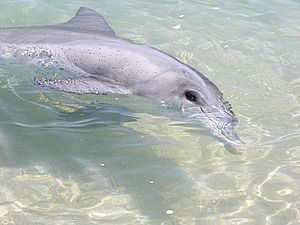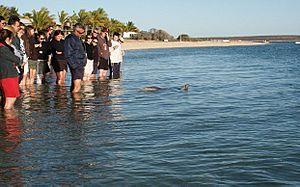Monkey Mia facts for kids


Monkey Mia is a very popular place for tourists in Western Australia. It's about 900 kilometers (560 miles) north of Perth. This special area is part of the Shark Bay Marine Park and the Shark Bay World Heritage Site.
The biggest reason people visit is to see the amazing bottlenose dolphins. These dolphins have been swimming close to the shore for over fifty years! Park rangers from the Department of Parks and Wildlife carefully watch over how people and dolphins interact. This makes sure everyone stays safe and the dolphins are protected.
Contents
The Story Behind the Name
The name "Monkey Mia" has an interesting history. The word Mia comes from the local Aboriginal language. It means "home" or "shelter."
The "Monkey" part of the name has a few possible stories:
- Some say it came from a pearling boat named Monkey. This boat anchored here in the late 1800s when pearling was a big industry.
- Another idea is that it came from a list of Aboriginal names. This list was made around 1899 and said "Monkey" meant "Salt or bad water."
- It might also be named after pet monkeys that early Malay pearlers kept when they camped here.
- Some people think it was a nickname for "sheep."
- Finally, it could be named after a schooner (a type of sailing ship) called Monkey that arrived in 1834.
A Look Back in Time
The Monkey Mia area was first officially recognized in 1890. It was used as a base for pearling and fishing.
In the 1960s, a fisherman and his wife started feeding the bottlenose dolphins. They would give them fish when they returned from their fishing trips. As more people heard about the dolphins coming close to shore, visitors began to arrive.
To help manage the growing number of visitors:
- An information center was built in 1985.
- In 1988, the government provided money to build better roads, parking areas, and other facilities.
In November 1990, the waters around Monkey Mia became a special marine park. The Department of Parks and Wildlife now looks after it.
More recently, people have paid more attention to the Aboriginal history of the area. They are learning from the local Aboriginal people's knowledge of the land. Visitors can now go on "culture walks" to learn about respecting the land.
Visiting Monkey Mia
Each year, about 100,000 tourists visit Monkey Mia. Most of them come specifically to see the famous dolphins.
Dolphin Encounters
A small group of dolphins regularly swims to the shore up to three times a day. Usually, about seven or eight dolphins visit often, while up to 20 others come less frequently. It can take several years for new dolphins to feel confident enough to come close.
Park rangers are always there to carefully watch the interactions. They hand-feed fish to the dolphins. Visitors are asked not to touch the dolphins. This strict management means only five adult dolphins are fed, and they get no more than 10% of their daily food from humans. This helps them stay wild and healthy.
Dolphin Research
Monkey Mia is also a very important place for scientists to study bottlenose dolphins. Researchers Richard Connor and Rachel Smolker started the Monkey Mia dolphin research project in 1982. They were drawn to the area because of the famous "beach dolphins."
Their studies quickly grew to include hundreds of other dolphins in nearby Shark Bay. Since their first visit, scientists from top universities in Australia, North America, and Europe have come to study here. This international team of scientists has been studying the dolphins very closely since 1984.


